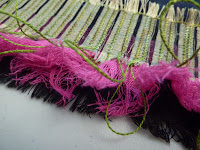I've been looking at creating samples of decorative edges using different techniques - can't promise innovation but hopefully not boredom. These samples are subdivided into technique categories but as usual there will be a bit of overlap. Once I started on this I realised that, aside from samples getting easily lost, they needed to be presented together in some format so I have 'bound' them staggered in a kind of cloth reference book of edges. I'll post photos of them together later but for now each sample is generally photographed separately.
Turned Edges
 |
| 8.6 |
8.6 The edge material has been pin tucked on the diagonal then turned up and 3 channels filled with braided cord. The loose ends have been knotted.
 |
| 8.7 |
8.7 Wide turn-up created, numerous staggered buttonholes made then felted cords run through them.
 |
| 8.8 |
8.8 Diamond shapes sewn in satin stitch, interior cut out then fabric turned up to reveal interesting gaps. A braided cord runs through this channel.
 |
| 8.9 |
8.9 Cut out strip of decorated felt attached to fabric edge, turned up and held in place with a gold cord passed through tabs and looped around the cut strip. I've added the scissors into the photo to show where the turn-up is.
Bound edges
These 3 samples are shown on the same photo 8.10 with photo 8.11 showing the reverse side of the bound edge matching the front side.
 |
| 8.10 |
 |
| 8.11 |
 |
| 8.12 |
In the bottom sample, the raw edge is hemmed with decorative fly stitch and turned edge bound with felt braids passed through buttonholes.
In the middle the raw edge is wrapped in a freemachine sewn grid (8.12), held in place with braid tabs.
In the top edge the raw edge was wrapped in chiffon, pattern sewn by free machine (resembling some of the petal design features on the last post) then cut away by soldering on both sides.
Faced edges
 |
| 8.13 |
8.13 A shaped edge was created in the black fabric using a turned seam then wet felted leaves free embroidered and added on top.
 |
| 8.14 |
 |
| 8.15 |
 |
| 8.16 |
8.14 These 'drips' came from drawings/prints of large folded leaves in my sketchbook from Module 1 (shown in 8.16). Thin fabric shapes and thick felt shapes were caught in the lower seam of the facing before turning right side out. Another chiffon version of the shape was satin edged and caught in a second fold above that to overlap.
Frayed edges
 |
| 8.15 |
8.15 This sample has a black cotton backing with frayed edge with pink frayed muslin gathered and folded to resemble the fluted tops to the "orchid" flowers of the original inspiring fabric. The olive silk dupion was frayed to exploit the 'shot' nature of the fabric and reveal a stripe pattern (as in the original). Cabling with green perle emphasised the stripes
 |
| 8.16 |
8.16 This sample similarly looks to the stripes for inspiration and uses frayed black hessian, frayed dyed muslin threaded and knotted through the hessian, and paper beads hanging on the 'tassels' created from the hessian.
Ruffles
Various ruffles were made from bias strips of poly chiffon. I overlocked the edges to give some firmness.
 |
| 8.17 |
8.17 Bottom - simple even ruffle gathered along one side and inserted into edge facing.
Middle - wider ruffle gather off centre line, folded and stitched down along fold to give a tiered ruffle.
Top - ruffle increasing in size l to r.
Flounces
Flounces are cut from circular shapes to give fullness without gathering at the sewn edge.
 |
| 8.18 |
8.18 These flounces were cut from 3/4 of circles of cotton with internal circumference approx. 22cm, external circum 44cm. The flounces differed only in the position of the internal circle for cutting (see diagram beside each flounce). The length of the internal circle circumference and therefore the length of the seam was the same in each case. The bottom flounce was set into the facing hem while the others were each sewn into a horizontal pleat in the green fabric.
 |
| 8.19 |
8.19 Flounce in chiffon made from 2 complete circles set into a vertical seam. I think this might be useful in my later interpretation of one of the fabric pattern
designs for the orchid-like flowers.
Stitched edges
 |
| 8.20 |
 |
| detail |
8.20 This edge was created on water soluble fabric using an automatic stitch pattern repeatedly to buildup the lace then a perle 8 thread couched over lace and fabric.
 |
| 8.21 |
8.21 Leaf shapes free machined towards edge of chiffon. Edge of shapes and some internal areas removed with soldering iron. Lace leaves sewn by free machining, attached to this edge using watersoluble fabric.
 |
| 8.22 |
8.22 To create a folded lace edge, free machining and cabling done in spirals between two edges of chiffon over water soluble fabric. Once dissolved away, the new lace was folded to create the new edge (8.23).
 |
| 8.23 |


























































